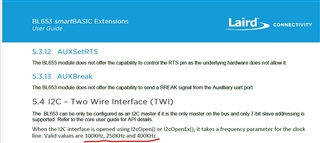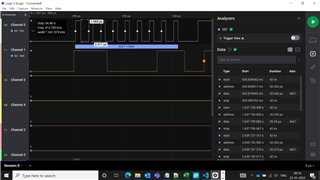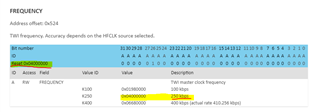Hi,
We have 2 queries regarding I2C modes,
1. I2C fast speed mode
We are undergoing test of I2C under I2C_SPEED_FAST - 400Khz
when we enable this frequency on our logic analyzer we are able to read 413Khz as attached in screenshot, we are using laird bl653 (document attached - CS-GUIDE-BL653-DVK_v1_0-1855868.pdf)
we need to know the tolerance of acceptance ? is 413Khz acceptable ?
2. We want to know more about I2C speed modes,
as per speed configurations in i2c.h there are following configurations
I2C Standard Speed: 100kHz - I2C_SPEED_STANDARD
I2C Fast Speed: 400kHz - I2C_SPEED_FAST
I2C Fast Plus Speed: 1MHz - I2C_SPEED_FAST_PLUS
I2C High Speed: 3.4MHz - I2C_SPEED_HIGH
I2C Ultra Fast Speed: 5MHz - I2C_SPEED_ULTRA
as per above configurations & mentioned detail here https://docs.zephyrproject.org/latest/reference/peripherals/i2c.html, we don't have 250Khz config
and attached in laird bl653 document (CS-GUIDE-smartBASICEXT-BL653 v30_2_2_0_0.pdf) it mentions 250Khz (document and screenshot attached)
we want to have more clarity about speed configurations in I2C


CS-GUIDE-BL653-DVK_v1_0-1855868.pdf
CS-GUIDE-smartBASICEXT-BL653 v30_2_2_0_0.pdf
Thank you,



